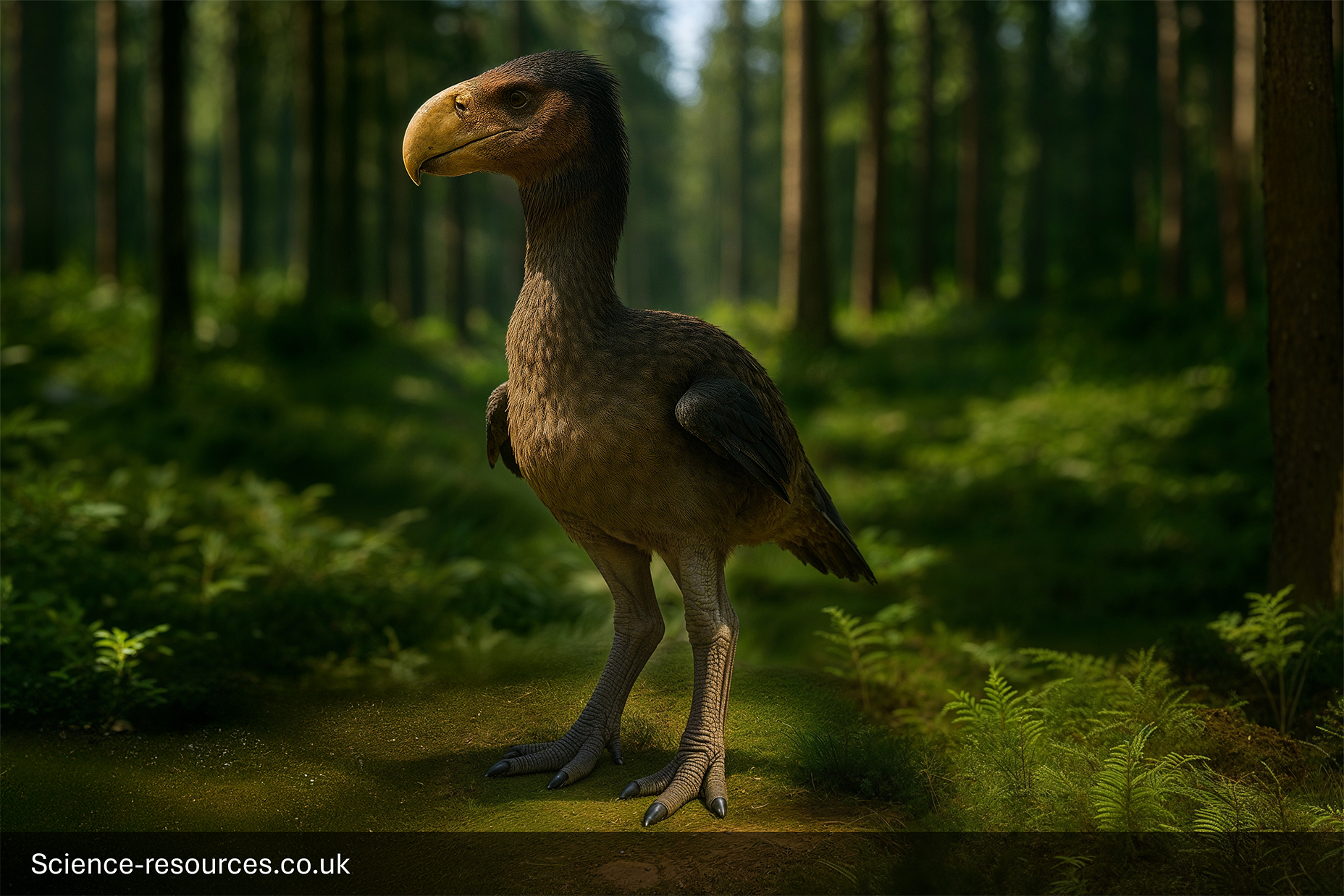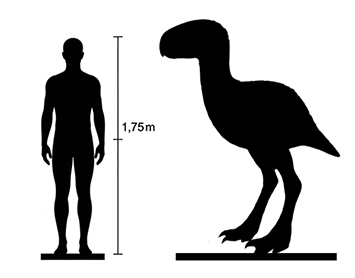Last updated: 4th August 2025
Extinct Animals: Gastornis
Gastornis, a giant flightless bird, was one of the largest birds to have ever lived.
Gastornis (The Giant Bird)
 Gastornis
Gastornis
Generative AI Notification: Some elements of this image have been created or enhanced using AI technology. To find out how we create all our prehistoric animals, click here.
What is Gastornis?
Gastornis was a genus of huge, flightless birds that lived during the Eocene epoch.
How big was Gastornis?
It stood over 2 meters (6.5 feet) tall and had a massive, powerful beak.
What did Gastornis eat?
Recent research suggests it was a herbivore, using its beak to crack open hard nuts and seeds.
Gastornis appearance
It was a stocky, heavy-bodied bird with powerful legs and a large head dominated by a huge beak.
Where did Gastornis live?
Fossils have been found in Europe, North America, and Asia.
Interesting facts
It was once believed to be a fierce carnivore, earning the nickname "terror bird," but is now thought to be a plant-eater.

Gastornis Facts
Pronounced: GAS-tor-niss
Name Means: Named after French geologist Gaston Planté
Length: Up to 2 meters (6.5 feet)
Height: Around 2 meters (6.5 feet) tall
Weight: Estimated around 200 kilograms (440 pounds)
Diet: Likely Herbivore (though once thought to be carnivorous)
Time: Paleocene to Eocene Epochs (about 56 to 41 million years ago)
Fossils Found: Europe, North America, and Asia
Which family of animals did Gastornis belong to?
It belonged to the family Gastornithidae, an extinct group of flightless birds.
What other animals lived at the same time as Gastornis?
The giant bird Gastornis shared its prehistoric forest home with amazing animals like the dog-sized "dawn horse" Eohippus, small primates, and large lizards including crocodiles.
Gastornis FAQ
Q1: What was Gastornis?
A1: Gastornis is an extinct genus of large, flightless birds that lived during the Paleocene and Eocene epochs, approximately 56 to 41 million years ago.
Q2: Where have Gastornis fossils been found?
A2: Fossils of Gastornis have been discovered in Europe, North America, and Asia, indicating it had a wide geographic range.
Q3: How big was Gastornis?
A3: Gastornis could grow up to 2 meters (6.5 feet) tall and weigh around 100–150 kg (220–330 lbs), making it one of the largest birds of its time.
Q4: Was Gastornis a predator?
A4: Earlier theories suggested Gastornis was a carnivore due to its massive beak, but more recent evidence points to it being herbivorous, feeding on tough plant material.
Q5: What did Gastornis look like?
A5: Gastornis had a large, powerful beak, a robust body, long legs, and small wings, indicating it was flightless. Its appearance was somewhat similar to modern-day cassowaries or emus.
Q6: Is Gastornis related to modern birds?
A6: Gastornis is part of an extinct group of birds and is not directly related to any living species, though it shares distant ancestry with waterfowl like ducks and geese.
Q7: What was the environment like when Gastornis lived?
A7: Gastornis lived in warm, forested environments with abundant vegetation, which supported a variety of mammals and other birds.
Q8: How was Gastornis first discovered?
A8: The first fossils were found in France in the mid-19th century and were initially thought to belong to a giant mammal. The genus was named Gastornis in honor of French paleontologist Gaston Planté.
Q9: Did Gastornis have any predators?
A9: As one of the largest animals in its ecosystem, adult Gastornis likely had few natural predators, though juveniles may have been vulnerable to carnivorous mammals.
Q10: Why did Gastornis go extinct?
A10: Gastornis likely went extinct due to climate changes and ecological shifts during the Eocene, which altered its habitat and food sources.
You may also be intrested in:
- Extinct Animals: A-Z
- Dinosaurs: A-Z
Tags: How big was Gastornis, Gastornis, where did Gastornis live, how tall was Gastornis, what does Gastornis mean, Gastornis facts
Previous: Entelodont
Up next: Hyaenodon
© 2012 science-resources.co.uk. All rights reserved | Design by W3layouts
Extinct Animals: Gastornis
Gastornis, a giant flightless bird, was one of the largest birds to have ever lived.
Gastornis (The Giant Bird)
 Gastornis
Gastornis
Generative AI Notification: Some elements of this image have been created or enhanced using AI technology. To find out how we create all our prehistoric animals, click here.
What is Gastornis?
Gastornis was a genus of huge, flightless birds that lived during the Eocene epoch.
How big was Gastornis?
It stood over 2 meters (6.5 feet) tall and had a massive, powerful beak.
What did Gastornis eat?
Recent research suggests it was a herbivore, using its beak to crack open hard nuts and seeds.
Gastornis appearance
It was a stocky, heavy-bodied bird with powerful legs and a large head dominated by a huge beak.
Where did Gastornis live?
Fossils have been found in Europe, North America, and Asia.
Interesting facts
It was once believed to be a fierce carnivore, earning the nickname "terror bird," but is now thought to be a plant-eater.

Gastornis Facts
Pronounced: GAS-tor-niss
Name Means: Named after French geologist Gaston Planté
Length: Up to 2 meters (6.5 feet)
Height: Around 2 meters (6.5 feet) tall
Weight: Estimated around 200 kilograms (440 pounds)
Diet: Likely Herbivore (though once thought to be carnivorous)
Time: Paleocene to Eocene Epochs (about 56 to 41 million years ago)
Fossils Found: Europe, North America, and Asia
Which family of animals did Gastornis belong to?
It belonged to the family Gastornithidae, an extinct group of flightless birds.
What other animals lived at the same time as Gastornis?
The giant bird Gastornis shared its prehistoric forest home with amazing animals like the dog-sized "dawn horse" Eohippus, small primates, and large lizards including crocodiles.
Gastornis FAQ
Q1: What was Gastornis?
A1: Gastornis is an extinct genus of large, flightless birds that lived during the Paleocene and Eocene epochs, approximately 56 to 41 million years ago.
Q2: Where have Gastornis fossils been found?
A2: Fossils of Gastornis have been discovered in Europe, North America, and Asia, indicating it had a wide geographic range.
Q3: How big was Gastornis?
A3: Gastornis could grow up to 2 meters (6.5 feet) tall and weigh around 100–150 kg (220–330 lbs), making it one of the largest birds of its time.
Q4: Was Gastornis a predator?
A4: Earlier theories suggested Gastornis was a carnivore due to its massive beak, but more recent evidence points to it being herbivorous, feeding on tough plant material.
Q5: What did Gastornis look like?
A5: Gastornis had a large, powerful beak, a robust body, long legs, and small wings, indicating it was flightless. Its appearance was somewhat similar to modern-day cassowaries or emus.
Q6: Is Gastornis related to modern birds?
A6: Gastornis is part of an extinct group of birds and is not directly related to any living species, though it shares distant ancestry with waterfowl like ducks and geese.
Q7: What was the environment like when Gastornis lived?
A7: Gastornis lived in warm, forested environments with abundant vegetation, which supported a variety of mammals and other birds.
Q8: How was Gastornis first discovered?
A8: The first fossils were found in France in the mid-19th century and were initially thought to belong to a giant mammal. The genus was named Gastornis in honor of French paleontologist Gaston Planté.
Q9: Did Gastornis have any predators?
A9: As one of the largest animals in its ecosystem, adult Gastornis likely had few natural predators, though juveniles may have been vulnerable to carnivorous mammals.
Q10: Why did Gastornis go extinct?
A10: Gastornis likely went extinct due to climate changes and ecological shifts during the Eocene, which altered its habitat and food sources.
Tags: How big was Gastornis, Gastornis, where did Gastornis live, how tall was Gastornis, what does Gastornis mean, Gastornis facts
Previous: Entelodont
Up next: Hyaenodon
© 2012 science-resources.co.uk. All rights reserved | Design by W3layouts